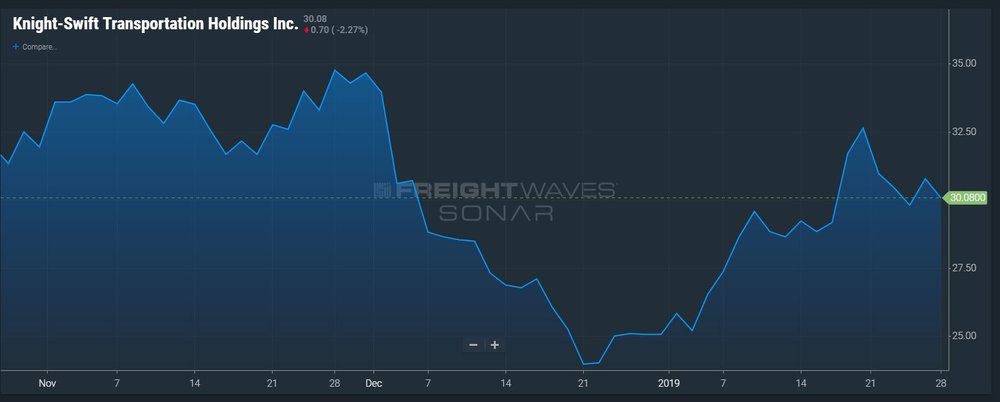Some highlights from the Knight-Swift (NYSE: KNX) fourth quarter earnings statement:
– Knight Swift a few weeks ago said it was increasing its guidance on earnings both from the fourth quarter of 2018 and into 2019. On Tuesday, the company’s earnings release showed why. What was notable about the earnings was not just the revenue and the income figures but the company’s operating ratio (OR) across its units. Knight Trucking saw its non-adjusted OR improve to 81.5 percent from 84.6 percent (and favorable fuel charges kicked that up to 78.1 percent for the quarter.) Swift Truckload saw its non-adjusted OR rise a significant 760 basis points to 78.8 percent from 86.4 percent. Swift Dedicated had an OR that moved up 230 basis points to 86.7 percent, and Swift Refrigerated, whose performance in the second quarter of 2018 spooked investors and led to a sector-wide stock selloff, saw its OR tick down only slightly to 93 percent with a revenue decline of 2.6 percent. “We made sequential Adjusted Operating Ratio improvements in the third quarter and fourth quarter of 2018 in both the over-the-road and dedicated businesses within this segment, and we continue to refine our strategy to improve profitability in 2019,” the company said about Swift Refrigerated in its earnings statement.
– The improved OR in the Swift Truckload division came despite a 13.2 percent drop in revenue. Operating income was up 35.6 percent. “The significant year-over-year improvement was driven by a 5.9 percent increase in average revenue per tractor, improved safety results and cost control,” the company said in its earnings statement, discussing the better results. “We have emphasized improving revenue per tractor over the last year, which has led to a change in our freight mix and 9.3 percent fewer miles per tractor.”

– Knight Trucking had no such cutbacks. Its revenue excluding fuel and intersegment transactions was up 21 percent. Its operating income was up 46.6 percent and that powered the 310 bps improvement in non-adjusted OR. “The strong freight market and tight capacity supported increases in both contract and non-contract rates throughout the quarter,” Knight Swift said in its earnings statement. The average revenue per tractor was up 12.2 percent and the average tractor count was up 7.9 percent.
Wall Street liked what it saw, even though the strong quarter already had been foretold. The company’s non-adjusted earnings per share of 86 cents per share beat consensus estimates by 7 cents per share, according to SeekingAlpha. Total revenue of $1.39 billion missed by $40 million, which is about 2.8 percent. At approximately 10:45 a.m., Knight Swift stock was up 2.59 percent, or 78 cents, to $30.86. That increase for Knight Swift stock easily outpaced other trucking stocks and the broader S&P 500, which was down slightly at 10:45 a.m.
– Things are looking good so far in 2019, the company said. “After experiencing a strong freight market in the fourth quarter of 2018, which supported increases in both contract and non-contract rates, we are experiencing typical seasonality thus far in the first quarter of 2019,” the company said. “We expect contract rate improvements to continue in 2019, but at a slower pace than in 2018.”
– This will be the last time the company reports Knight and Swift as separate entities. The company will create a trucking segment that will include Knight Trucking, Swift Truckload, Swift Dedicated and Swift Refrigerated. The Logistics segment will include Knight brokerage and Swift logistics. The Intermodal segment will include Swift Intermodal and Knight Intermodal, the latter of which had been in Knight Logistics. Knight bought Swift in April 2017.
– Knight Swift discontinued its earnings calls with investors in the third quarter of 2018 and continued that for its fourth quarter 2018 earnings.












